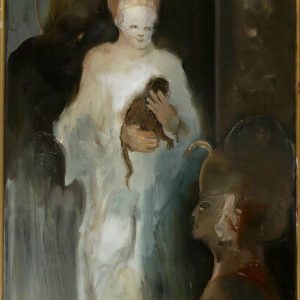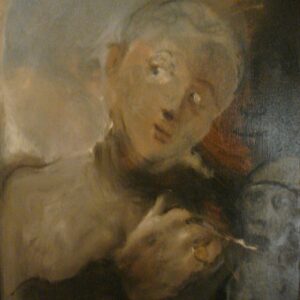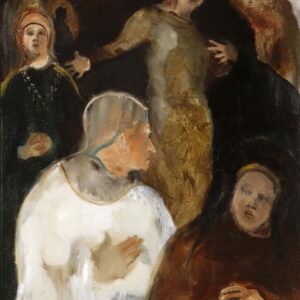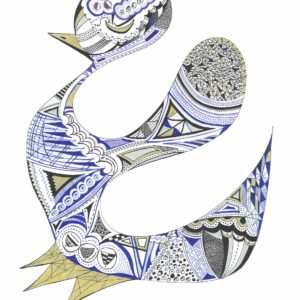Description
Artist/Maker: Yannis Papayannis (b. 1962)
Object/Materials and Techniques: Oil / Gold / Silver on Canvas
Date: Painted in 2015
Dimensions: H. 55 cm. x W. 40 cm.
Art style: Abstract art / Expressionism / Gesturalism
Current Location: Artist’s collection
Curator’s note: A series of allegorical paintings which, according to the artist, constitute:
‘a wager with myself to make pictures about a specific short piece of music, Luciano Berio’s 3rd part of his ‘Sinfonia‘, by using eleven seemingly diverse things like interviews, photos, artworks and other fragments of music, I thought they related directly, incidentally or metaphorically to the 3rd Part.
- Documentary on Luciano Berio, Voyage to Cythera (inspiration)
- Luciano Berio, the 3rd Part of the Sinfonia (intuition)
- Samuel Beckett, The Unnamable (spatial ascending lines)
- Luciano Berio, Diary Notes (spatial ascending lines)
- Antoine Watteau, The Voyage to Cythera (background)
- The seven colours of the Sumerian Temples: silver, blue, yellow, gold, red, orange, black (background)
- Gustav Mahler, Scherzo from Second Symphony (expressive element)
- Photos of bombs exploding on the surface of the sea (expressionistic element)
- Van Gogh, Swirl paintings (expressionistic element)
- 10.Gunter Foerg, painting in the Foundation Barnes (colour palette)
- 11. Johannes Itten, Complementary colour theory (colour enhancement).‘
Yanis Papayanis’s inspiration derives directly from the relevant documentary Voyage to Cythera (element 1) based on Luciano Berio’s music composition Sinfonia (element 2) which includes crucial parts for eight amplified voices.
The Italian composer’s intuition, especially on the 3rd Part where the music interacts with Samuel Beckett’s writings in his book The Unnamable (element 3), is dynamically reflected onto Keep Going canvases by means of conjoining musical layers and textual references. Thereafter, the way the spatial ascending lines are illustrated in the paintings -one of Yanis Papayanis’ most characteristic personal verbal idioms- may give the impression of melodic lines that simultaneously are stringing with the words, just like the eight voices confound with the orchestra in Sinfonia.
At the same time, the spatial ascending lines suggest a kind of inner self-expression or deep monologue within the self. They pass on Luciano Berio’s Diary Notes (element 4) like fragments of inmost questions, answers, meditations or comments, farthest within, as a form of ‘intermezzi’.
The background of the syntheses brings in mind the rhythmical structure of the popular courtly scene (fêtes galantes) in the self-titled masterpiece Voyage to Cythera as depicted by Antoine Watteau (element 5). In addition, the chosen colour palette of the background represents the seven colours of the Sumerian Temples of Ancient Mesopotamia: silver, blue, yellow, gold, red, orange, black (element 6), a pattern extensively used by Yanis Papayanis as background in his oeuvres.
An eloquent expressive style is readily, clearly and effectively dominant throughout all four compositions of My Creative Times Guests series, further influenced and developed by Gustav Mahler’s most successful work, the Symphony No. 2, and more particularly by its scherzo that features a part for a solo violin in C minor (element 7).
Moreover, Yanis Papayanis’s immense desire to express emotion is highly driven both by the thrilling effect of Vincent Van Gogh’s famous expressionistic swirl paintings (element 8) on him while also by the impact of photos of bombs exploding on the surface of the sea (element 9). The osmotic force of this desire is stated via a powerful colour selection that recalls Günther Förg’s coolly coloured paintings in the Barnes Foundations (element 10), as much as via a successful colour enhancement that reveals from Johannes Itten’s complementary colour theory according to which the contrast is formed by the juxtaposition of colour wheel or perceptual opposites (element 11).
On the whole, a harmonious tonal framework for a certain piece of music is being developed within an overall tuneful composition. As the artist himself expresses in words ‘…it was an instinctive path which started by listening to the music, scribbling on paper, unrolling and rearranging my Guests and later by changing, reconsidering and amending the images on the canvas‘. Abstracted forms and colour gradations much like deliberately and intentionally aspire to emulate musicality and provoke contemplation as they ‘keep going’ with melodies, sounds and tones.
On this wise, just like human’s gestures reflect personal feelings on particular instants, correspondingly Yanis Papayanis’s portrayed explosive gesturalism, through intense brushstrokes, expresses both deep emotions and subconscious reactions upon listening to music, and more specifically to a specific short piece of music, by further becoming an automatic pattern of the artist’s behaviour in reflex to this particular and special loved situation.
Yanis Papayanis’s inspiration derives directly from the relevant documentary Voyage to Cythera (element 1) based on Luciano Berio’s music composition Sinfonia (element 2) which includes crucial parts for eight amplified voices.
The Italian composer’s intuition, especially on the 3rd Part where the music interacts with Samuel Beckett’s writings in his book The Unnamable (element 3), is dynamically reflected onto Keep Going canvases by means of conjoining musical layers and textual references. Thereafter, the way the spatial ascending lines are illustrated in the paintings -one of Yanis Papayanis’ most characteristic personal verbal idioms- may give the impression of melodic lines that simultaneously are stringing with the words, just like the eight voices confound with the orchestra in Sinfonia.
At the same time, the spatial ascending lines suggest a kind of inner self-expression or deep monologue within the self. They pass on Luciano Berio’s Diary Notes (element 4) like fragments of inmost questions, answers, meditations or comments, farthest within, as a form of ‘intermezzi’.
The background of the syntheses brings in mind the rhythmical structure of the popular courtly scene in the self-titled masterpiece Voyage to Cythera as depicted by Antoine Watteau (element 5). In addition, the chosen colour palette of the background represents the seven colours of the Sumerian Temples of Ancient Mesopotamia: silver, blue, yellow, gold, red, orange, black (element 6), a pattern extensively used by Yanis Papayanis as background in his oeuvres.
An eloquent expressive style is readily, clearly and effectively dominant throughout all four compositions of My Creative Times Guests series, further influenced and developed by Gustav Mahler’s most successful work, Symphony No. 2, and more particularly by its scherzo that features a part for solo violin in C minor (element 7).
Moreover, Yanis Papayanis’s immense desire to express emotion is highly driven both by the thrilling effect of Vincent Van Gogh’s famous expressionistic swirl paintings (element 8) on him, and the impact of photos of bombs exploding on the surface of the sea (element 9). The osmotic force of this desire is stated via a powerful colour selection that recalls Günther Förg’s coolly coloured paintings at Barnes Foundations (element 10), as much as via a successful colour enhancement that reveals from Johannes Itten’s complementary colour theory according to which the contrast is formed by the juxtaposition of colour wheel or perceptual opposites (element 11).
On the whole, a harmonious tonal framework for a certain piece of music is being developed within an overall tuneful composition. As the artist himself expresses in words ‘…it was an instinctive path which started by listening to the music, scribbling on paper, unrolling and rearranging my Guests and later by changing, reconsidering and amending the images on the canvas‘. Abstracted forms and colour gradations much like deliberately and intentionally aspire to emulate musicality and provoke contemplation as they ‘keep going’ with melodies, sounds and tones.
On this wise, just like human’s gestures reflect personal feelings on particular instants, correspondingly Yanis Papayanis’s portrayed explosive gesturalism, through intense brushstrokes, expresses both deep emotions and subconscious reactions upon listening to music, and more specifically to a specific short piece of music, by further becoming an automatic pattern of the artist’s behaviour in reflex to this particular and special loved situation.
Notation:
- Luciano Berio (1925 – 2003) was an Italian composer and a pioneer in electronic music. He is noted for his experimental work, in particular his composition Sinfonia (1968) and his series of virtuosic solo pieces titled Sequenza.
- SamuelBarclay Beckett (1906 – 1989) was an Irish Nobel Prize – winner dramatist playwright, avant-garde novelist and poet.
- Voyage to Cythera(1717) (L’Embarquement pour Cythère) is a famous painting by the French painter Jean-Antoine Watteau (1684 – 1721). It is also known as The Embarkation for Cythera and Pilgrimage to the Isle of Cythera (fêtes galantes).
Jean-Antoine Watteau is credited with inventing the genre of fêtes galantes, scenes of bucolic and idyllic charm, suffused with a theatrical air. Therefore, some of his best-known subjects were drawn from the world of Italian comedy and ballet.
- Gustav Mahler (1860 – 1911) was an Austrian – Jewish composer, noted for his 10 symphonies and various songs with orchestra, and one of the leading conductors of his generation, acting as a bridge between the 19th century Austro-German tradition and the Modernism of the early 20th century.
- Günther Förg (1952 – 2013) was an abstract German painter, graphic designer, sculptor and photographer that explored a lifelong fascination with Modernism. His abstract style was influenced by American abstract painting. From his early monochromatic pieces to his images of significant architecture, Förg engaged with the formalism of 20th-century avant-garde movements. His abstract canvases reference and subvert the modernist repertoire, while his architectural photographs feel like an approximation of the geometry and colour palette of the paintings.
- The Barnes Foundation is an art collection and educational institution promoting the appreciation of art and horticulture. Originally in Merion, the art collection moved in 2012 to a new building on Benjamin Franklin Parkway in Philadelphia, Pennsylvania. One of the world’s greatest collections of impressionist, post-impressionist & modern art.
- Johannes Itten (1888-1967), Swiss colour theorist and artist, was one of the first people to define and identify strategies for successful colour combinations. Through his research he devised seven methodologies for coordinating colours utilizing the hue’s contrasting properties.
Bibliographic References:
- Donald Posner, Antoine Watteau, London, Weidenfeld & Nicolson, ISBN 0-8014-1571-3. OCLC 10736607.
- Peter Stacey, Contemporary Tendencies in the Relationship of Music and Text with Special Reference to “Pli selon pli” (Boulez) and “Laborinthus II” (Berio), New York, London, Garland, 1989.
- Hugh Kenner, Samuel Beckett: A Critical Study, New York, NY, Grove Press, 1961.
- Deryck Cooke, Gustav Mahler, An Introduction to His Music, London, England, Faber Music, 1980, ISBN 978-0-571-10087-3.
- Bruce Weber, Günther Förg, German Artist Who Made Modernism His Theme, Dies at 61, New York Times, 18 December 2013.
- Alex Greenberger, Hauser & Wirth Now Represents the Estate of Günther Förg, ARTnews, June 1, 2018.
- Johannes Itten and Faber Birren, The Elements of Colour: A Treatise on the Colour System of Johannes Itten Based on His Book The Art of Colour, New York, Van Nostrand Reinhold, 1970, ISBN 0-442-24038-4.

![Yannis Papayannis – Keep Going (1/4) [From the series My Creative Times Guests]](https://www.n-art.org/wp-content/uploads/2019/04/PAPAGIANNIS-2.1-scaled.jpg)



